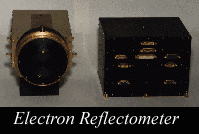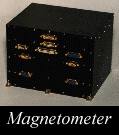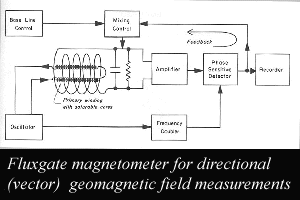
Mars Global Surveyor Magnetic Field Experiment
The MGS Magnetometer and Electron Reflectometer
The magnetometer and electron reflectometer instruments are measuring the magnetic properties of Mars. On Earth, a magnetic field surrounds the planet. The magnetism results from electric currents circulating in the molten iron churning slowly in the Earth's core. Mars does not presently have a global magnetic field but had one early in its life, similar to that of Earth. However, Mars does have very strong crustal magnetic fields, more than 30 times stronger than those of Earth. Magnetic fields are usually measured in units of "gamma", for our purposes we use the equivalent "nanoTesla" unit.
Unlike the other instruments, the magnetometer sensors are not attached to the main body of the spacecraft. Instead, each one of the two sensors sits at opposite ends of the spacecraft at the tips of Surveyor's two solar panels. This placement ensures that the data generated from the magnetometer sensors will not be "polluted" by magnetic signals from the spacecraft system.
 |
 |
The electron reflectometer sensor is mounted on the instrument platform because it is not sensitive to weak magnetic fields.
The magnetometer and electron reflectometer were operational during the cruise phase of the mission. During the aerobraking phase the MGS spacecraft crossed the Martian bow shock formed by the supersonic interaction of the planet with the solar wind at least twice per orbit. The MAG/ER detected these crossing and generated valuable data for determining the global extent of the Martian magnetic field. During aerobraking, the MAG/ER also made magnetic field measurements at altitudes 7-8 times lower than any previous spacecraft to visit Mars.
During the mapping orbit, except when the MGS spacecraft is in contingency-mode, the MAG/ER is operating continuously - and has done so for over 3 Martian years (1 Martian year equals 687 Earth days). MAG/ER has obtained detailed maps of the interior and crustal magnetic fields of Mars, and measured variability in magnetic fields and electron distributions with a number of controlling factors, including season, solar wind pressure, interplanetary magnetic field direction, and solar extreme ultraviolet (EUV) flux.
Fluxgate (Saturable-Core) Magnetometer
The fluxgate magnetometers implemented for the Mars Global Surveyor are based on similar instruments developed for numerous previous missions Voyager, Magsat, International Solar Polar mission, Giotto, Active Magnetospheric Particle Tracer Explorers, etc.). The basic configuration consists of dual; wide-range, triaxial flux gate sensors mounted remote from the spacecraft's body. Assuming that this field is primarily dipolar in nature at the location of the magnetometer sensors, the ambient field can then be analytically determined by combining the outboard and inboard measurements.In a magnetometer of this type, the nonlinearity of magnetization properties for the high permeability of easily saturated ferromagnetic alloys provides an indicator of the local field strength. The word "fluxgate" is used to refer to the method of periodic switching of magnetic flux in the detector.

Click on picture for larger view
For taking measurements of weak magnetic fields, enhancements are made to the second harmonic detection. "In one method, two parallel cores are wound in opposing directions in the excitation field circuit, and a single secondary coil encompasses both. The two primary contributions into the pickup windings are thereby canceled. The example above illustrates such a system, which utilizes second harmonic phase detection. With specifically selected cores and careful construction, sensitivities of a few milligamma have been obtained. In recent years, the cores have been fashioned in the shape of a ring, just about a centimeter in size, and the excitation and pick up windings have been made toroidally about the ring." (Intro to Geomagnetic field, Wallace H. Campbell, p. 187).
The MGS flux gate sensors are constructed utilizing the ring core geometry, which has been shown to exhibit superior performance characteristics in terms of long-term zero-level stability and drive power requirements when compared to other types of flux gate sensors. In addition, the magnetic material used to manufacture these sensors is the latest in a series of advanced molybdenum-pemalloy alloys, which have been especially developed for low-noise, high stability applications.
The signals from the magnetometers are first processed by their respective analog electronic subsystems and then fed to the digital-processing unit (DPU). Depending on the spacecraft telemetry mode, variable time resolution formats are derived from the basic measurements. This subsystem also provides the necessary information to the microprocessor to activate the automatic range control logic in the magnetometer electronics. If the magnitude of the measured vector component exceeds reselected threshold values, the dynamic range (scale factor) of each magnetometer is incremented or decremented to maintain maximum digital resolution.
Both inboard and outboard magnetometers are sampled at a rate of 32 samples per second by a clock system derived from the spacecraft data system real-time interrupt clock (RTI). These "raw" samples are then averaged according to the telemetry mode selected for the spacecraft and the data rate allocated to the experiment.
Contributors: David Brain, Monte Kaelberer, Cisco Perin, and Theresa Valentine






